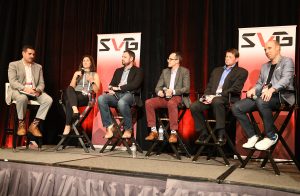2019 Esports Production Summit: Tips and Considerations for Venue Design
Story Highlights
Creating gaming meccas for local Esports communities was the topic of a panel discussion at the SVG Esports Production Summit that gave attendees some top tips for meeting a growing market segment.

(l-to-r) SVG’s Kristian Hernandez moderated a panel discussion on venues with Kristin Connelly, Corey Dunn, Jud Hannigan, Bob Jordan, and Brian Mirakian.
Kristin Connelly, Overwatch League, Senior Director, Marketing, on the need to have a venue that resonates with Esports fans.
You need to make Esports arenas feel communal and authentic as it is their event and they are like-minded, rooting and cheering. You need to program moments to make it feel real and believable, you can’t just show up to the venue. Take every single moment and have activations in breaks. Do something engaging and fun.
Corey Dunn, Esports Stadium Arlington, VP of Broadcast & Esports Locker, President, on the need to be flexible to meet diverse event needs.
You need different ways to showcase players without dwarfing them…to focus on the players without over dramatizing it. And the venue needs to feel different and you need to coordinate with [the client] on things like the LED canvas and staging so that you can help the audience engage further with the subject matter. You can have the most polished product in the world, but it is the subject and content that matters most.
Jud Hannigan, Allied Esports International, Co-Founder and CEO, on the need for creativity in venue design.
The element of creativity is never going to stop. A facility needs to deliver unique experiences for each game publisher. How is it going to feel special every time someone new comes to town? A key component is modularity and flexibility.
Remember that Esports fans love partners.
Connelly: They embrace partners and they love the validity that big sponsors bring to Esports.
Bob Jordan CVE, 1337 Facilities, CEO; Venue Road, Founder, on the ability to use Esports to bring new fans into traditional venues.
TD Garden in Boston did an event and 50% of those who were 18-34 had never been in the Garden before. It was a completely new fan base and they also have a different model when it comes to supporting amenities versus the repetition and getting caught in a silo.
Jordan on starting with the basics and flexibility.
You want a venue with black walls, black ceiling, lighting, and then a lot of programmable video. Connectivity is also essential. And then flexibility has to be the next thing on the list. It doesn’t matter what the game is, you have to be adaptable to whatever the customer or gaming base needs.
Jordan on the need to survey your fans and gamers to see what they want out of a venue.
We did focus groups with our clients and the gamers and students that came in wanted a place to play on a higher-quality tournament level rig. And then they also wanted a place to socialize with other gamers. So, yes, it is about play but then they also want it to be communal and to have interaction as part of the environment.
Brian Mirakian, Populous, Senior Principal and Director of Brand Activation, on remembering the soft products in a venue.
Esports is unique and activations should key in on merchandise, food and beverage and blend the virtual and real world together. It’s ultimately about a great socialized experience where people feel like it is their own.
Mirakian on the “post-suite” culture.
Young audiences want to be in a more socialized environment rather than a traditional suite. They want something more like bottle service in 12 person boxes or customized media experiences that allow them to follow players or tap into a stats feed. But there is not a template for it. There are a lot of different ways to activate and create a venue around Esports. It will grow and evolve over time.
